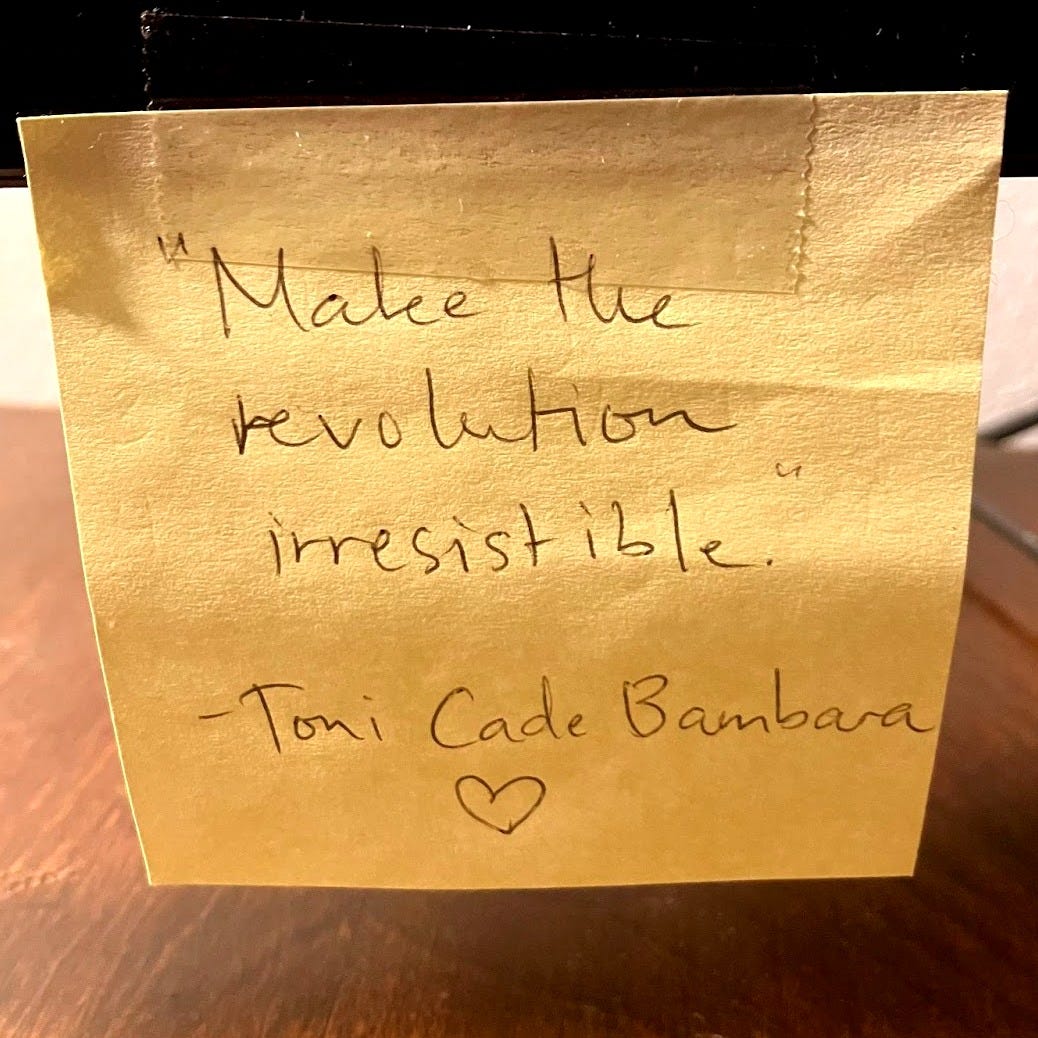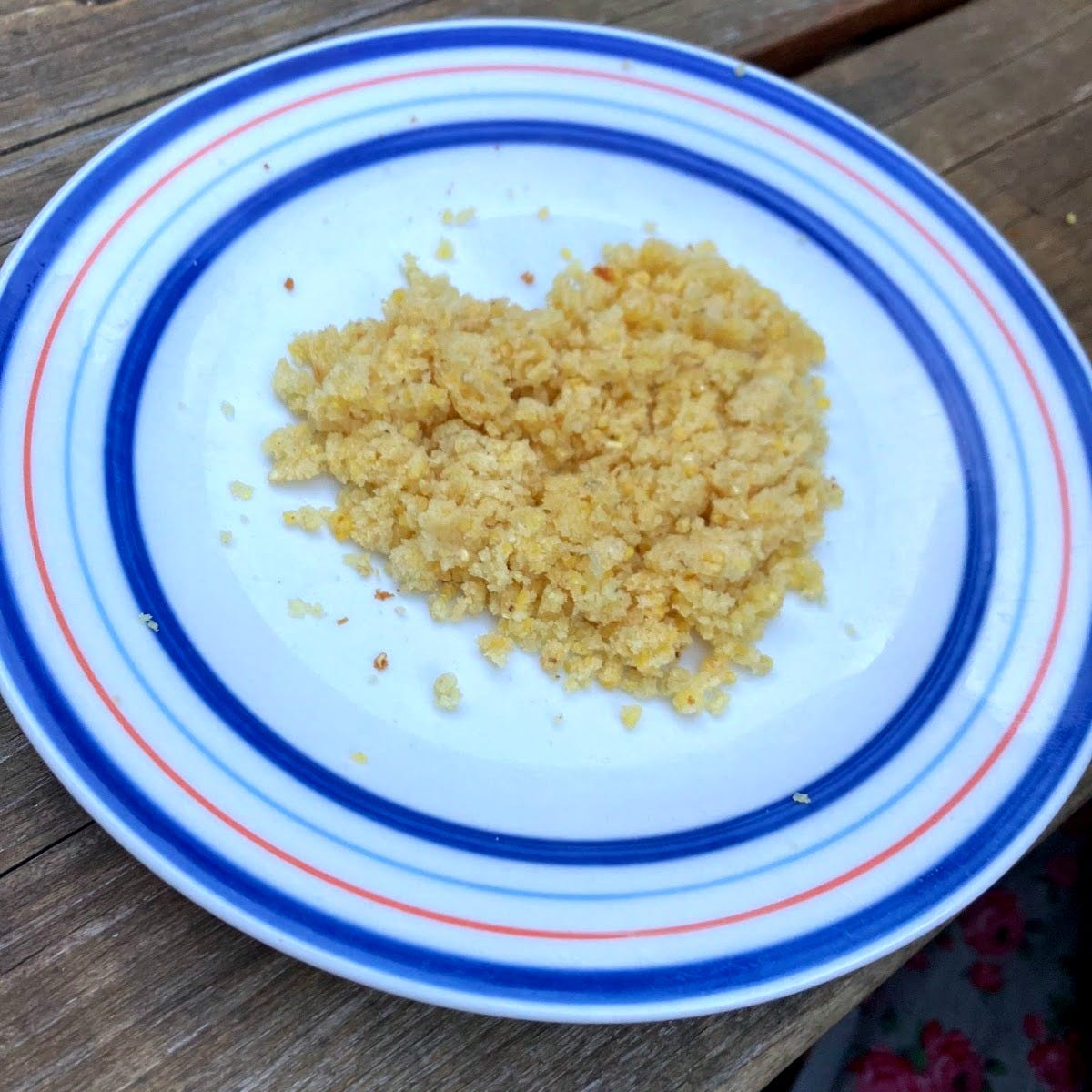Making the Revolution Irresistible: The Auntie Bulletin Strategic Plan for 2025 and Beyond
I’m afraid it involves Beanee Weenee.
Hi, Aunties. Thanks for opening this post. I know you have many options for things to read and pay attention to, yet you clicked on something with “strategic plan” in the title, bless your heart. You must be a big nerd like me! I’m so glad we’re here together!
Today’s post is longish and it covers a lot of terrain. I’m including a Table of Contents and I invite you to read like you would any strategic plan for an organization you care about. Skim. Focus on the parts that interest you.
AIM: A Future of Kinship and Community Care
METHOD, Pt. 1: Building an Auntie Movement
METHOD, Pt. 2: Making the Revolution Irresistible
WHO WE ARE: The Auntie Collective
CONTENT: For Your Attention
AIM: A Future of Kinship and Community Care
In last week’s post, I wrote about Choose Democracy’s framework outlining the roles people can play in creating a better future.
I shared my hope that The Auntie Bulletin can be a cultural engine, however modest, for envisioning and building alternatives. I wrote:
Rather than responding to each new catastrophe as it arises (which I frankly can’t sustain), I see this newsletter as a place to keep steadily banging the drum for the world we want to live in. I aim to help slowly, purposefully, and lovingly change the cultural narrative about what’s possible – so that two or twenty or even two hundred generations from now, all people might be able to live well supported by their communities, free from exploitation, in a clean and safe and healthy world.
So let’s envision some alternatives, Aunties. Let’s dream big. Let’s imagine for a few minutes that we can wave a magic wand and bring about the society we want to live in.
I envision a society where Auntiehood is widespread and is recognized as a viable, valued life choice. People (especially women) enter into parenthood from a place of informed consent, and they have access not only to a strong social safety net, but also to a wide community of loved ones to help distribute the tasks of parenting and daily life. Our kin include not only our nuclear family, but also our close friends and our neighbors, and those people have constellations of familial and chosen kin, too. Through our kinship networks we are strongly linked, like forest plants linked by root systems and mycelium networks and the branches of the canopy overhead. Nobody brings home a new child to an empty fridge. Nobody is judged for having children or for not having children. Nobody can’t find childcare. Nobody dies destitute and alone. Nobody has nobody.
Is this vision idealistic? Of course. Is it unrealistic? No. Most societies, for most of human history, have been tightly connected by expansive networks of kinship and community. In most societies, for most of human history, care for pregnant people, new parents, children, the disabled, the sick, and the elderly was easy to come by. Indeed, in some communities today, this way of living is still the norm. As a species, we absolutely know how to live like this. In fact, it’s how we’re built.
I know that we can build robust, distributed kinship networks because I am actively engaged in doing so in my own life, and I know that many other Aunties who read this newsletter are as well. The more local kinship networks we build, the more interlinked they may become, until entire communities may be held within reciprocal, well-resourced networks of care.
This is within reach. It can be done. And crucially, it doesn’t rely on the will or courage of our elected officials to make it happen – although the more we build the future we want to live in, the more our elected officials may be motivated to have our backs.1
Related Reading from The Auntie Bulletin
METHOD, Pt. 1: Building an Auntie Movement
While we’re dreaming big, let’s wave our magic wand again and imagine how to achieve a future based on communities of care.
I would love to see an Auntie Movement take hold in our time.
By “Auntie Movement,” I mean a lot of people talking and writing about Auntiehood, and a lot of people choosing Auntiehood, and a lot of people understanding their choice not only through a personal lens but also through a political one.
And by Auntiehood, I mean not simply “being an aunt,” but rather loving and showing up for children who aren’t our own, as well as for the primary caregivers of those children. Auntiehood might also involve wrapping other adults into our kinship networks – especially those who are sick, disabled, or elderly and don’t have kin nearby to help them out.
I want Aunties to feel seen and heard and understood. We should be able to choose an alloparental role without being judged for choosing the “easy” alternative to parenting, without being marginalized as “not real family,” and without the illegibility of, “Who are you again? Why are you here?” Aunties aren’t rare, and we aren’t outsiders – not to families, and not to political movements.
I want Aunties to feel like part of something – part of the families we love, but also part of political movements to which we have much to contribute. I want us to have opportunities to connect with others who have had similar experiences and made similar choices. I want us to be able to recognize what we are doing as important, and good for society, and downright revolutionary. And I want us to be able to speak with confidence about these experiences and welcome others who are interested in joining our movement.
METHOD, Pt. 2: Making the Revolution Irresistible
How can we build an Auntie Movement? We make it attractive. We surface what is wonderful about Auntiehood – for ourselves, for the people we love and care for – and we model it and talk about it all the time.
In 1982, the writer, filmmaker, and activist Toni Cade Bambara was asked about “the task of the artist.” She responded that it depends on whose agenda you aim to serve. If you serve the interests of what she called “the bourgeois capitalist class,” then you’ll create art that maintains the status quo. But if you want to resist your own and others’ oppression, you need to “make revolution irresistible.”
When I first came across this quotation, I scribbled it on a sticky note and stuck it to my computer monitor, and there it has remained — for years. I love that Bambara doesn’t just call for revolution. Instead, she argues we need to make revolution irresistible. There’s the status quo, or there’s a revolution people actually want to join. There is no other option.
I think this insight is valuable because frankly, activist and movement building spaces can be hard to join.2 The content may be grim – long explorations of oppression with little to no attention to how we can build agency or organize people to make change. It can be repetitive – once you’ve been in social justice spaces for a while, you’ll have answered the same questions about when you first became aware of your race or your gender many times. These spaces may also feel unwelcoming and cliquish, as though everyone already knows each other, has cool artsy punk bona fides, and has very specific expectations around language. If you say the wrong thing (or even say the right thing in the wrong way), you may be met with condescension or downright censure. Parents of small kids have a hard time attending because all the meetings are at 7pm. In more formal spaces, cost can also be a huge factor. The nonprofit fundraiser costs $500 a plate to attend; the academic conference registration fee is $349, plus a $119 annual membership fee – not to mention the price of graduate school.
If we want our revolution to be irresistible, then we need to make it warm, welcoming, and meaningful – a lot like Auntiehood.
I say this often but it bears repeating: being an Auntie is a radical, culture-changing practice. Over the past few generations, societies have had a nuclear family model foisted upon us — a model that teaches us to fend for just ourselves and our immediate family members, to look out for only our own. Being an Auntie, on the other hand, means actively choosing to care for people who aren’t necessarily part of our family. And by loving and caring for other people’s children,3 we build our muscles for loving and caring for other people’s parents, other people’s families, other people’s communities – other people’s people.
Fortunately, these muscles are easy to build once we get going. Especially when we are well-supported and the load is equitably distributed, caring for others feels great. It soothes our nervous system and nourishes our soul. It’s addictive. It’s irresistible.
WHO WE ARE: The Auntie Collective
I have two goals for what I offer you in 2025 and beyond, Aunties.
First, I want The Auntie Bulletin to be supportive and fun to read — not one more responsibility in your inbox. I don’t know about you, but I’m subscribing to a lot of email newsletters these days. Some I usually open on arrival, some I get around to within a few days, some I save for when I can really settle in and savor them (these do pile up), and some that go unread and that I eventually, guiltily delete. For the record, I think all of these newsletter reading (or not reading) behaviors are legit.
I wanted to know where y’all were at with your newsletter intake, so I surveyed you in December. I wasn’t surprised when 83% of respondents shared that they “sometimes” or “always” struggle to keep up with their newsletter subscriptions. One reader wrote:
Multiple newsletters, are you kidding me?? I'm not even reading a book right now. The only regular time I have for reading is the 45 min between the time I wake up and the time I have to get up to make my grandson's daytime meals and take him to school.
Being real, I hope The Auntie Bulletin makes it into the 45 minutes or howevermuch time you have in your day or week to read. So I’m pursuing what I think of as the Beanee Weenee approach, trying to make this newsletter nutritious and delicious. (The Beanee Weenee jingle wormed into my head in 1990 and has never left. It’s a blessing and a curse).4
By nutritious, I mean I hope The Auntie Bulletin will provide practical everyday support for building kinship ties, strengthening community, increasing our collective capacity, and creating a better world. This is where the radical politics of Auntiehood stuff comes in. And by delicious, I mean I hope this newsletter is entertaining, that my dumb jokes occasionally make you laugh, that the images and videos add some fun to your day. I even hope that some of the political stuff will taste delicious sometimes – an opportunity to savor the taste of a future we want to live in.
My second goal is for this newsletter to feel like a shared space – one where readers are in conversation not only with me, but also with each other. Right now, I respond to pretty much every comment on the posts I write, but over time I hope we’ll have enough subscribers and enough people participating in the comments that Aunties can find real connection and support regardless of when I weigh in.
Another place I’m eliciting reader participation is in monthly Auntie Collective Wisdom surveys. Our first Collective Wisdom survey gathered readers’ contributions to the New Baby Bill of Rights — contributions that made that post much, much stronger. As of this writing, the current Collective Wisdom survey elicits perspectives on community love for our elders, and will inform a post on the topic next month. Complete the Love for Elders survey and be entered to win a 12-month paid-tier subscription to The Auntie Bulletin! Note: You need to be logged into Substack.
The Collective Wisdom surveys will keep coming, concerning a range of topics of interest to our community. There will always be a paid subscription prize, and I hope over time everyone will find surveys they want to weigh in on. Coming up, look for surveys on these topics:
What unique contributions can Aunties make that aren’t always available to parents?
Teachers, how do you want to be appreciated?
Complicated Mothers Day
Grandparents, what do you want families to know?
On not being intimidated by teenagers
The other main spot for reader interaction on Substack is the chat feature (accessible via web or the app). I experimented early on but never found momentum. I’m thinking of trying again, and my best idea is to share an interesting insight from something I’m reading about Auntiehood (have I mentioned I’m writing a book?), and then pose a question or two that I find intriguing. For example, right now I’m reading Jody Day’s excellent Living the Life Unexpected: How to Find Hope, Meaning, and a Fulfilling Future without Children, and she has this to say:
It came as a huge shock to me, having been brought up to earn my own living and consider myself a man’s equal, to find myself as a single, childless woman in my forties with no social value or position and being expected to occupy a silent third place after men and mothers.
So I might post this quotation in the chat and ask you if it resonates. We could do that with all kinds of powerful, compelling, confronting ideas. What do you think? Would you be interested?
Let’s wrap up this section with some reader demographics. As of this writing, about 10% of all Auntie Bulletin readers have responded to the New Reader survey (it goes out in the welcome email people receive when they subscribe). By social science researcher measures, that’s an okay response rate. It’s definitely not a precise reflection of Auntie Bulletin reader demographics, but I suspect we’re in the ballpark.
Here’s some reader survey data that often steers my thinking about who you might be. (And hey, let’s give it up for the 5% of Auntie Bulletin readers who identify as men. We’re so glad you’re here!)
Gender. When asked about their pronouns (“select all that apply”), 92% reported that they use she/her, 5% they/them, and 5% he/him. Several people wrote in she/they.5
Active Auntiehood. 71% report being “somewhat” or “very” involved in the lives of the kids in their lives, while 25% report that they hope to be in the future.
Auntie roles. 61% identify as familial or non-familial Aunties of any gender, 17% are parents, and 7% grandparents (this is another “select all that apply,” and smaller percentages report that they are stepparents, foster parents, teachers, childcare providers, or have other childful roles).
Infertility. When asked if they have experienced infertility, 16% answered “yes” or “it’s complicated.”
Involuntary childlessness. When asked if they are involuntarily childless, 23% answered “yes” or “it’s complicated.”
Note: It’s never too late to complete the New Reader survey – I always appreciate info about who’s reading. You’ll need to be logged into Substack.
Related Reading from The Auntie Bulletin
CONTENT: For Your Attention
Look, this is my strategic plan, so if I want to write about Beanee Weenee or take a quick detour into the implications of my scholarly research for moral philosophy, I’m going to do it.
Here’s the detour: For the past few years, I’ve been working on an educational research study in which my colleague Stephanie Forman and I explore parents’ choices about where to send their kids to school. Specifically, we talked to urban parents with progressive values who initially opted for public school but later moved their kids to private school. Many parents we talked to felt they had to make this choice for the safety or wellbeing of their child, but also felt the decision had knocked them out of alignment with their values around diversity and the public good.
What we realized about reluctant leavers – here comes the moral philosophy part – is that when people have made life choices that feel out of alignment with their values, they tend to feel like they have dirty hands. (Believe it or not, “dirty hands” is a technical term among moral philosophers). And when people feel like their hands aren’t clean, they often believe they have ceded their ethical standing on the issue. They’re like, “I took my kid out of public school, so who am I to lobby for education funding at the state capitol?” This kind of thinking is totally understandable, it comes from a place of integrity – and it’s wrong.6
Okay, so here’s my point: A lot of the issues and topics I’d like to center at The Auntie Bulletin are the kind where people tend to worry that our hands might not be clean – for example, the foster care system. Going forward, I’ll be writing about foster kids and foster families more regularly because foster children are arguably the most vulnerable members of society. If we’re invested in showing up for other people’s children, then foster kids need to be on our radar. That said, most of us – myself included – are not in a position to actually become foster parents. And I don’t know about you, but deep down, I feel guilty about this.
What I want to argue, though, is that just because we can’t become foster parents right now doesn’t mean we can’t support foster kids and foster families. In the coming months, I’ll be publishing interviews with foster parents and with professionals in the foster care system, and we’ll be thinking about what non foster parents can contribute. I’m also going to start contributing 5% of Auntie Bulletin subscription revenues to an organization that supports foster families. I’m currently taking nominations, so drop those in the comments, reply to this email, or email me at auntiebulletin at gmail dot com if you know of a good one!
Coming attraction: My sister’s besties are a queer interracial couple who, at the ages of 21 and 23, became foster parents to four children under the age of 2. My interview with them blew my mind and cracked open my heart and I can’t wait to share it with you.
What Aunties understand is that we do have the standing to participate in domains that aren’t precisely ours. Even if we don’t have kids of our own, we know how to roll up our sleeves and help raise other people’s kids. Similarly, even if we don’t have foster children, we might be able to help smooth the way just a little bit for foster families and foster kids. (Ideas coming to your inbox soon).
Here are some other issues and groups I’ll be centering going forward. If you’re like me, you’ll feel like an insider in some cases and an outsider in others. My hope is that The Auntie Bulletin can help all of us – myself included – cultivate the agency and sense of moral standing to let these causes take up space in our hearts and develop competence to meet them.
Elders. Robust networks of kinship are intergenerational. As an Auntie without kids of my own, I hope in my old age to have friends of younger generations who I can love and support and who will love and support me, too. Elders who don’t have adult children in particular may benefit from finding chosen family from across age groups.
Coming attraction: An wise, heartful interview with Jody Day of Gateway Elderwomen. For love of our childless elders (with contributions from the Auntie Collective). How to befriend your elders.
People with disabilities and chronic illnesses. It’s hard to be an Auntie with a chronic illness that constantly saps my energy. I hear often from other Aunties in similar situations, including some whose health conditions are much more impactful than my own. Going forward, we’ll be exploring Auntiehood with disability and chronic illness, and we’ll also think about supporting families with kids who have special needs. The disability justice community has long led the way on the conversation about carework (although their ideas are often ignored or neglected), and I’m excited to dive in.
Coming attraction: How to introvert while chronically ill and on vacation with children. Auntiehood with disability. Supporting families where kids have special needs, with Shane Meyer-Holt of Untethered.
Multiparent families and alternative family structures. When I say “multiparent” I mean more than two. When I say “alternative family structures,” I don’t just mean stepfamilies or kids being raised by grandparents (although those may well be included); I also mean families that are totally rethinking the nuclear family structure. Queer families and communities have long led the way on this.
Coming attraction: Two queer couples, three kids, one family under one roof. Creches and other family structures in utopian science fiction.
Grief. Losing a child is the worst thing that can happen to a parent. If the unthinkable happens, Aunties may have important support roles to play. We also need to be able to navigate our own grief when a child is lost — or when we can’t have them in the first place. Here’s looking at you, 23% of Auntie Bulletin readers who are involuntarily childless. There’s so much loss there, and most people honestly don’t get it.
Coming attraction: Complicated Mothers Day with Ryan Rose Weaver of In Tending.
Climate justice. Caring for kids means caring for the planet they’re inheriting, full stop. As a comparatively affluent American (who, for example, flies on airplanes several times a year), I know my hands aren’t clean. Going forward, we’ll be exploring how we can discharge our responsibilities to other people’s children by staying grounded and taking practical everyday actions to advocate for climate justice.
Coming attraction: Climate justice, kinship, and Auntiehood with Anya Kamenetz of The Golden Hour.
Public school. My buddy Stephanie and I will soon be launching a whole new newsletter about this one! When you don’t have kids of your own (or when you send your kids to private school), it can be hard to know how to support public schools. But good news: we’ve got ideas for you!
Coming attraction: Welcome to Public School All Stars!
I’m so excited about this coming attractions lineup, I feel like I’m basically just showing off at this point. But boy is this all going to be nutritious and delicious, Aunties! Beanee Weenee indeed.
In Conclusion
As a 4 year old I know says: “Phewf!”
This has been a long post, and I sure do appreciate your attention and support. Thank you for reading. Now, if you have any thoughts, reactions, suggestions, or questions, I’d love to hear them! You can drop those in the comments, reply to this email, or email me directly at auntiebulletin at gmail dot com.
Nothing Sold, Bought, or Processed
The Auntie Bulletin is an ad-free, anti-capitalist publication that will never try to sell you anything and receives no money from affiliate links. I can only offer it if readers like you make modest donations to keep the lights on. If you appreciate what you read here, please take a few seconds to become a paid subscriber.
Thanks for reading all the way to the end! You get the secret scoop that if you can’t afford a paid subscription due to financial hardship, you can reply to this email, shoot me a message in the Substack app, or email me at auntiebulletin at gmail dot com and I’ll comp you a 12-month paid tier subscription, no questions asked.
As Hamilton Nolan has brilliantly explained, “The true work of political action is not to identify idealized superheroes to run for office. It is, instead, to create the conditions in the world that make it safe for the cowards to vote the right way.”
I’m far from the first to make this point. Recently, Ryan Rose Weaver, Elise Granata, and Garrett Bucks have all written beautifully about it. And here’s adrienne maree brown making a related point, and here are Angela Davis and Fania Davis.
The phrase “other people’s children” comes from a major piece of multicultural education research: Lisa Delpit’s 1995 book, Other People’s Children: Cultural Conflict in the Classroom. It explores how teachers can support students of color – a subject matter rather different from that of The Auntie Bulletin, although the values are aligned. Mea culpa for not acknowledging Delpit’s influence sooner.
Confession: I have never actually tried Beanee Weenee.
I opted to ask about gender in the New Reader survey because it feels extra important for writing a newsletter about carework. Other axes of identity like race, language, nationality, sexual orientation, disability, or political ideology also shape our experiences of care, and I may run a more detailed demographic survey in the future.
This research hasn’t been published yet, but I’ll let you know when it comes out.













I love a good strategic plan, Lisa. And I'm excited for everything the Auntie Bulletin is bringing to my life, and to all of our lives more generally!
Also, re: demographic data, I just wanna shout out to my fellow 5% Male-Identifying Aunties (eg Uncles). Woo! Traitors to the patriarchy, unite!
Love your strategic plan. I want to build this world